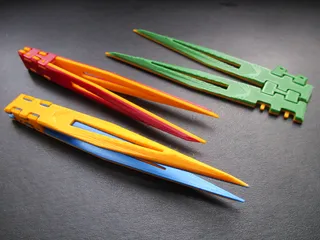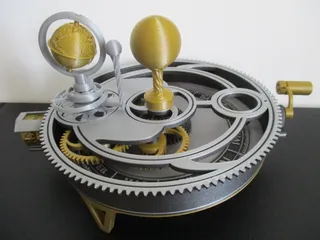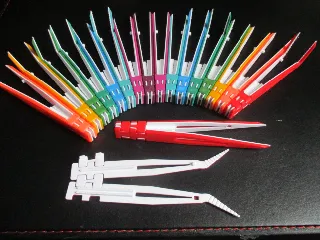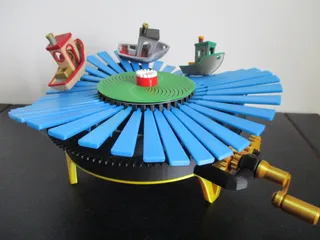Mechanical Moon Calendar
Description
PDF#NoScrewNoGlue
All you need to know about the Moon :
- Moon Phases
- Tilt of the Moon (Rising Moon / Waning Moon / Lunar knots)
- Apogee and Perigee
- Moon and Solar Eclipses
The mechanism is pretty complex with 10 wheels but the object stays simple - only 12 pieces. No screw, no glue or nothing else is needed.
The mechanism is precise enough to stay accurate for several years (1 day delay after more than 10 years).
This Moon Calendar is inspired by the famous orrery of James Ferguson (1710-1776). I transformed it into a geocentric version on which I added the Moon and so it is a Moon Calendar.
What is a geocentric Moon Calendar ?
This is a representation of the Sun-Earth-Moon system showing the Earth in the middle and the Moon and the Sun rotating around.
- The Sun is representated at the outside of the big rotating ring and shows the date on the calendar. It is a 365 days calendar (without February 29th)
- The Moon is represented by the small circle. It rotates around the Earth in 29.53 days.
- The orbit of the Moon is not a perfect circle but an ellipse with a perigee (closer point) and an apogee (far point).
- The orbit of the Moon has a tilt (5.14°) compared to the ecliptic plan (Sun and Earth plan).
- The Earth is inclinated on its axis (23°) and the North hemisphere points toward the summer solstice (June 21th).

How to use it ?
Use the drawing at the back to know the initial position. I used the last “big” solar eclipse (July 2nd 2019) as the reference position.

Rotate (anti clockwise) the large disk of the Sun until you reach the date you want.
Do no rotate too fast.
Print Settings :
Printed on MK3S
Filament tested : PLA (Filamentum/Prusament)
Nozzle 0.4mm : 0.20mm and 0.30mm tested
Take care of your printing precision (use a small file to correct the defects) :
- CONCENTRIC CANONS MUST BE PERFECTLY SMOOTH INSIDE AND OUTSIDE
- CONCENTRIC CANONS MUST BE PERFECTLY SMOOTH INSIDE AND OUTSIDE
- CONCENTRIC CANONS MUST BE PERFECTLY SMOOTH INSIDE AND OUTSIDE
- Check if all teeth are correct otherwise print the wheel again
- Ensure that your first layer is not larger (skirt effect)
- Try to correct every surface defects you noticed on the wheels
PrusaSlicer 2.3.0
Edit - 11 jan 2022 : the individual files of R15, R18-R30, Earth and Apogee have been changed - there was a scale issue (thanks a lot “stellarwave”).
“E pur si muove” - Galileo Galilei - 1633
Tags
Model origin
The author marked this model as their own original creation.




